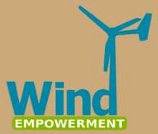| The VIRYA-3.5 and the VIRYA-3.18 windmills are designed especially for manufacture in developing countries. The VIRYA-3.5 has a simple2-bladed rotor with wooden blades connected to each other by a twisted steel strip. The blades have a constant chord with a Gö 711 airfoil and no twist and manufacture is therefore rather easy. The VIRYA-3.18 has a 2-blades rotor with 7.14 % cambered stainless steel blades with no twist which are connected to each other by a twisted stainless steel strip. The VIRYA-3.18 is designed for countries where good quality wood isn’t available or when machining and protection of wood is a problem. Both windmills make use of the same generator, head and tower. The PM-generator has a 45 mm shaft and a housing with a diameter of 320mm. The generator is mounted to the head frame by four blocks which clamp around the shaft. The centralstrip of the rotor is mounted to the front side of the generator housing by eight M10 bolts.The VIRYA-3.5 and the VIRYA-3.18 are meant for48 V battery charging. They have two 28 V battery charge controllers in parallel,so the windmills can be used for 24 V DC equipment. However, it is also possible to create a 230 V, 50 Hz stand alone grid by using an inverter. It might be possible to connect these windmills directly to the grid (so without batteries) using a 3-phase grid connected inverter but this use is not the main goal. It might be possible to use the generator as a brake by short-circuiting the generator winding. However, to be sure if the breaking torque is large enough, a generator has to be bought and measured. The windmill is provided with the so called “hinged side vane safety system” to limit rotor rpm and thrust at high wind speeds. The rotor axis is offset from the tower axis. The vane juts out along the rotor and the vane blade is connected to the vane arm using hinges. At low wind speeds, the vane blade hangs in almost vertical position and the rotor is perpendicular to the wind. At windspeeds higher than about 6m/s, the rotor starts to turn gradually out of the wind with a yaw angle δ. The rotor is about 30° turned out of the wind at a wind speed of about 10m/s. At very high wind speeds the rotor turns out of the wind by about 75° and the vane blade is in almost horizontal position. The behaviour of this system is very stable and the rotor speed is well controlled. A rough description of this safety system is given in the free public report KD 485. A detailed description is given in reports KD213and KD 223. The δ-V characteristic of the VIRYA-3.18 differs somewhat from that of theVIRYA-3.5 because a rotor with 7.14 % cambered blades has a larger self orientating moment than a rotor with a Gö 711 airfoil. This is the reason that the VIRYA-3.18 has a higher rated wind speed of 11 m/s in stead of 9.5 m/s for the VIRYA-3.5.A prerequisite for manufacture of this windmill in developing countries is that one is able to import some of the materials and standard parts. Kragten Design cannot supply materials and parts such as bearings, generators, electronics and batteries. The required workshop skills are sawing, drilling, turning, milling and welding.
|
|
Data
|
| Size |
196.22 KB |
| Download Language |
English |
| Author |
Dit e-mailadres wordt beveiligd tegen spambots. JavaScript dient ingeschakeld te zijn om het te bekijken. |
| Website |
Website  |
|
Download
|
|



 Renewable energy world
Renewable energy world
 Watt is duurzaam
Watt is duurzaam






